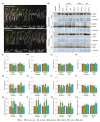Brassinazole Resistant 1 Activity Is Organ-Specific and Genotype-Dependent in Barley Seedlings
- PMID: 34948366
- PMCID: PMC8706524
- DOI: 10.3390/ijms222413572
Brassinazole Resistant 1 Activity Is Organ-Specific and Genotype-Dependent in Barley Seedlings
Abstract
Brassinosteroids (BRs) control many plant developmental processes by regulating different groups of transcription factors, and consequently gene expressions. The most known is BZR1, the main member of the BES1 family. However, to date, it is poorly characterized in crop species. The main goal of the presented study was to identify HvBZR1 and determine its activity in 5-day-old barley (the stage is related to one leaf on the main shoot and a few seminal roots) using two cultivars with different sensitivities to BRs. Using the anti-OsBZR1 antibody, we identified the forms of HvBZR1 transcription factor with different molecular weights, which can be related to different phosphorylated forms of serine/threonine residues. Two phosphorylated forms in the shoots and one dephosphorylated form in the roots were determined. A minor amount of the dephosphorylated form of the HvBZR1 in the Haruna Nijo shoots was also found. The phosphorylated forms gave a higher band intensity for Golden Promise than Haruna Nijo. The bands were similar in their intensity, when two different phosphorylated forms were compared in Golden Promise, while a reduced intensity was detected for the phosphorylated form with a lower molecular weight for Haruna Nijo. Degradation of the phosphorylated forms in the shoots (complete degradation in Golden Promise and significant but not complete in Haruna Nijo) and the presence of the dephosphorylated form in the roots were proven for the etiolated barley. In the case of Haruna Nijo, a wider range of the regulators of the BR biosynthesis and signaling pathways induced the expected effects, 24-EBL (0.001 µM) and bikinin (10 and 50 µM) caused low amount of the phosphorylated forms, and at the same time, a tiny band of dephosphorylated form was detected. However, the expression of genes related to the BR biosynthesis and signaling pathways was not a determinant for the protein amount.
Keywords: 24-epibrassinolide; BZR1; GSK3; Haruna Nijo; bikinin; brassinazole; glycogen synthase kinase 3; golden promise; root; shoot.
Conflict of interest statement
The authors declare no conflict of interest.
Figures



References
MeSH terms
Substances
LinkOut - more resources
Full Text Sources

